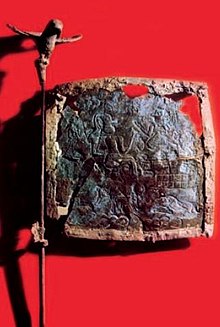
The Derafsh ( Persian: درفش) was a flag-like object used as a military standard by units in the Ancient Iranian (Persian) army.
History

Derafsh refers to a piece of skin or cloth, usually with different patterns and colors, which is used as one of the main symbols to identify relatives and gather together or show the direction of attack. It was originally made of wood, horn, bronze, animal skin and other carved and painted wood or metal ornaments. While there was no flag anywhere, Persians used a bronze flag for the first time which they called Derafsh Shahdad in 2400 BCE. [1] [2] [3] [4] Also, while Derafsh Shahbaz Shahbaz (bird) was used for the standard of Cyrus the Great, these flag-like banners were used for each unit of the Achaemenid army with different style and shapes in 550 BC. the Parthians used a bronze Derafsh Kaviani as a flag, which was tied to a cross bar on the top of the spear under the influence of Kaveh the blacksmith . Its image can be seen on the minted coins of the Parthian kings. Likewise, in the Sasanian Empire, the use of Derafsh Kaviani continued as the royal state flag, which was decorated with gold and precious stones. In modern day, Derafsh Kaviani has an ideological, cultural and intellectual role in modern Iranian nationalism.
List of Derafsh
- Derafsh Shahdad (Persian Wikipedia)
- Derafsh Shahbaz
- Derafsh Kaviani
References
- ^ Graef, Katrien De; Tavernier, Jan (7 December 2012). Susa and Elam. Archaeological, Philological, Historical and Geographical Perspectives.: Proceedings of the International Congress Held at Ghent University, December 14–17, 2009. BRILL. ISBN 978-9004207400 – via Google Books.
- ^ Pittman, Holly; N.Y.), Metropolitan Museum of Art (New York (12 December 1984). Art of the Bronze Age: Southeastern Iran, Western Central Asia, and the Indus Valley. Metropolitan Museum of Art. ISBN 9780870993657 – via Google Books.
- ^ Hansen, Donald P.; Ehrenberg, Erica (12 December 2017). Leaving No Stones Unturned: Essays on the Ancient Near East and Egypt in Honor of Donald P. Hansen. Eisenbrauns. ISBN 9781575060552 – via Google Books.
- ^ Hakemi, Ali; Archeologiche, Istituto italiano per il Medio ed Estremo Oriente Centro Scavi e Ricerche (12 December 1997). Shahdad: archaeological excavations of a bronze age center in Iran. IsMEO. ISBN 9788120410176 – via Google Books.